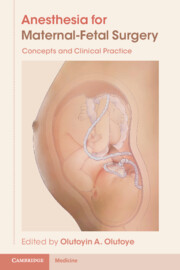Book contents
- Anesthesia for Maternal-Fetal Surgery
- Anesthesia for Maternal-Fetal Surgery
- Copyright page
- Dedication
- Contents
- Contributors
- Abbreviations
- Preface
- Acknowledgments
- Section 1
- Section 2
- Section 3
- Chapter 10 Myelomeningocele Repair
- Chapter 11 Lung Masses
- Chapter 12 Sacrococcygeal Teratoma
- Chapter 13 Ex-Utero Intrapartum Therapy
- Index
- Endmatter
- References
Chapter 10 - Myelomeningocele Repair
from Section 3
Published online by Cambridge University Press: 19 November 2021
- Anesthesia for Maternal-Fetal Surgery
- Anesthesia for Maternal-Fetal Surgery
- Copyright page
- Dedication
- Contents
- Contributors
- Abbreviations
- Preface
- Acknowledgments
- Section 1
- Section 2
- Section 3
- Chapter 10 Myelomeningocele Repair
- Chapter 11 Lung Masses
- Chapter 12 Sacrococcygeal Teratoma
- Chapter 13 Ex-Utero Intrapartum Therapy
- Index
- Endmatter
- References
Summary
Prenatal myelomeningocele has rapidly become the most common in-utero surgery performed following the results of the multi-center, myelomeningocele study. In-utero surgery has greatly improved the prognosis of babies with spina bifida or myelomeningocele. The eligibility criteria for this surgery has also evolved as some centers are now operating on mothers with increased body mass index (BMI). A BMI greater than 40 was not incorporated into the original study. In addition, fetoscopic repair of the myelomeningocele is also being performed, allowing for a decrease in the risk for uterine dehiscence and also offering mothers the opportunity to have a vaginal delivery following in-utero surgery.
Keywords
- Type
- Chapter
- Information
- Anesthesia for Maternal-Fetal SurgeryConcepts and Clinical Practice, pp. 137 - 151Publisher: Cambridge University PressPrint publication year: 2021



